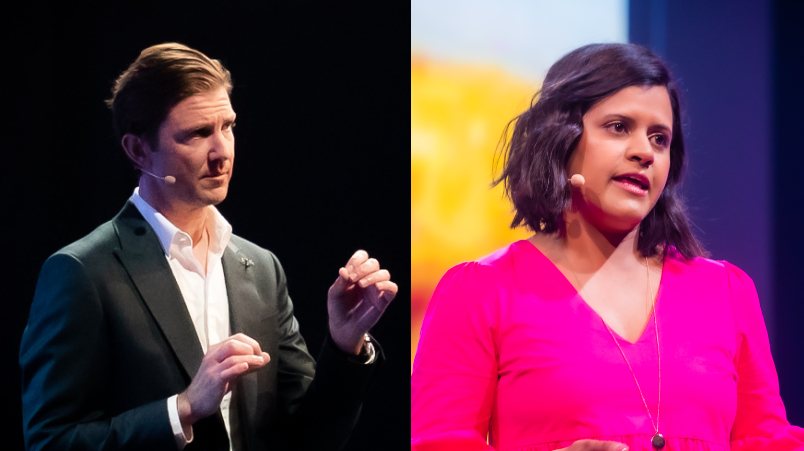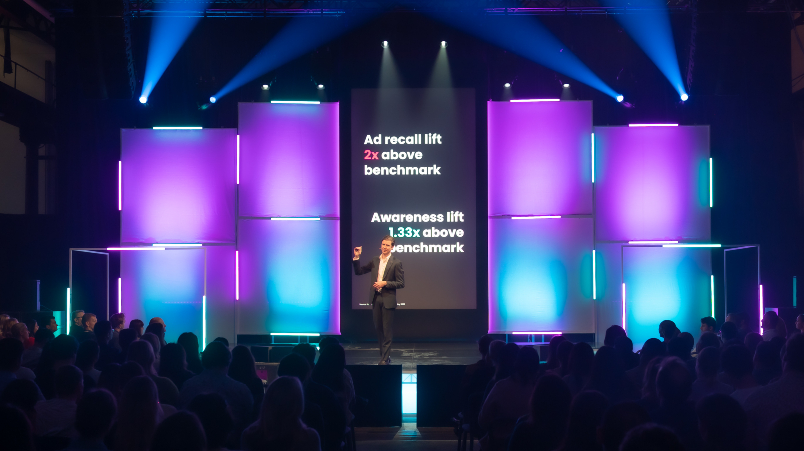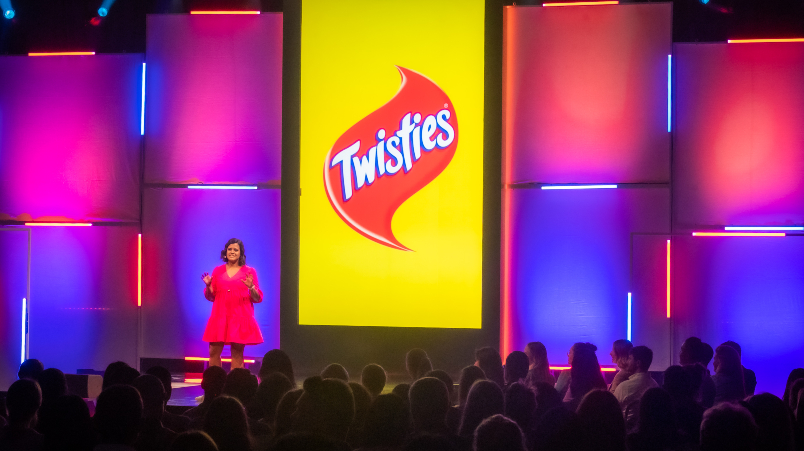TikTok Upfronts: PepsiCo, Mecca, Princess Polly pile in as platform overtakes Snap in ad revenues, hails ‘new era of entertainment’ with 33% cut in users' time on TV, streaming; rebuffs staff churn claims

TikTok's Brett Armstrong and PepsiCo's CMO Vandita Pandey.
TikTok took on the streamers and TV networks yesterday with a big stat to 300 advertisers and agency types that its fast-growing user base has slashed TV and streaming time by a third since it arrived in Australia. Blue chip and mid-size brands went public with ringing endorsements on results but TikTok still won’t officially disclose any details on its business here – user numbers, revenues or staff. The most aggressively expansionist media-social company in market at present – it is said to have an Australian team of circa 300 – rejected industry conjecture that its huge hiring blitz, where a new employee can double their package overnight, was facing a churn challenge because of aggressive revenue targets. “There’s no issues on churn,” TikTok’s local boss Brett Armstrong told Mi3. “At the moment we’ve got a really stable team and very low attrition.”
What you need to know:
-
TikTok made a play for brand and performance budgets at its first upfronts presentation, where Pepsi’s experiment to fix the troubled Twisties brand, by bundling media and creative with VaynerMedia, delivered benchmark results and returns from a major TikTok investment. Princess Polly represented the mid-size market with a glowing wrap on TikTok’s performance marketing prowess to drive sales.
-
TikTok has been disrupting the media and tech establishment with huge salary packages that can double overnight. But industry banter says it comes with high expectations on revenue performance which is affecting staff churn. Australian boss Brett Armstrong brushed-off the assertions.
-
TikTok is the fastest growing media business in the country at present and although it does not disclose any numbers, media agencies say it has overtaken Snap in revenues – likely well north of $100m.
-
Like Facebook, Instagram and Google, Tiktok is rapidly building its direct and SME customers but remains tight, for now, with the agency sector.
[TikTok are] launching shopping next year. If you think about how far ahead Meta is on things like that… once all that is launched, they could be unstoppable.
First up
Social and content platform TikTok is ruffling rivals with its huge staff salary packages and aggressive growth targets. Anecdotal reports from media agencies suggest it has now overtaken Snap in ad revenues and is second only in size to Meta’s Facebook and Instagram in social media. It is likely to be writing upwards of $100m in revenue although TikTok Australian General Manager Brett Armstrong said “we don’t talk about revenue growth…we don’t release the external [audience] number…we definitely do not talk packages and salaries.”
Armstrong said it was a “small industry” and TikTok had a responsibility to be attractive as an employer that went “beyond salary…it’s about culture, it’s about what we stand for, it’s about how we operate and make this a place where people want to come every day.”
For advertisers at least, TikTok’s fast growing audience – perhaps 7 to 10 million users but nobody seems to know – and user engagement is certainly working. PepsiCo CMO Vandita Pandey headlined the TikTok upfronts presentation with a glowing case study for its Twisties brand where “mental availability” among older segments remained strong but for millennials and Gen Z, Twisties was in real trouble. TikTok, she said, reversed the trend although afterwards Pandey told Mi3 that the runaway brand lift and business results for Twisties from its TikTok program was not a given for other brands in PepsiCo’s portfolio.
But to yesterday’s first upfronts event where TikTok touted a 33 per cent cut in television, streaming and video content viewing – at least among TikTok's user base – since it arrived on Australia’s shores.
TikTok Australia’s General Manager Brett Armstrong told 300-odd marketers and agency leaders in front of an enormous vertical mobile phone screen backdrop at Sydney’s Carriageworks that Australians were spending a “movie’s worth of time” on the platform every day – which equated to a lot of ads.
“In just two years, TikTok has changed our behaviour,” said Armstrong. “It's changed the way we discover and engage with brands. It's changed the way we search and share information and it's changed the way we create content. Since using TikTok, Australian users have spent a third less time watching TV, videos and streaming content. And a key reason for this? Because the platform sparks joy, especially in times of uncertainty.”
It was a confident pitch that, perhaps unusually for a short-form content platform, lasted about 1.5 hours. In 2023, the platform will launch its social commerce play, TikTok Shopping Ads, as well as catalogue listing ads and TikTok Pulse, which lets brands place ads after the top four per cent of high-performing videos in certain categories. TikTok is also getting into original content, commissioning a nine-part miniseries created by @jasminetxo (who has 5.7m followers) called Beauty is You, co-created by a division called Creator Productions Powered by TikTok. Armstrong insisted there were no plans for more series yet.

TikTok Australia's General Manager, Brett Armstrong, at its first upfront in Sydney.
Security, brand concerns
TikTok, owned by Chinese internet giant ByteDance, has been plagued by privacy and security concerns. Former US President Donald Trump threatened to ban the app, and India banned it in 2020 along with dozens of other Chinese-made apps. A US Federal Communications Commission [FCC] commissioner Brendan Carr in June asked Apple and Google bosses Tim Cook and Sundar Pichai in a letter to remove TikTok from their app stores. The request followed a Buzzfeed story days earlier that US data had been repeatedly accessed by China. Shortly after the Buzzfeed report, TikTok announced it was moving all its US user data to Oracle servers based in the US. The FCC's Carr said in his letter to the tech giant bosses that TikTok was "required by the Chinese law to comply with PRC's [Peoples Republic of China] surveillance demands." In a subsequent tweet Carr said: “TikTok doesn’t just see its users’ dance videos. It collects search and browsing histories, keystroke patterns, biometric identifiers, draft messages and metadata, plus it has collected the text, images and videos that are stored on a device’s clipboard.” Conversely, the head of the UK’s intelligence agency, GCHQ director Jeremy Fleming, said earlier this week he was happy with the way TikTok user data was safeguarded.
The platform flagged it worked with IAS on a brand safe pre-bid targeting product, while Armstrong said between April and June this year, TikTok pulled down 650,000 videos because they violated community guidelines. Ninety per cent of those were removed before users saw them.
Better together
TikTok is eating into both broader TV and performance platform spend, Armstrong said, as direct-to-customer brands try lower funnel tactics and FMCG giants look for more reach and frequency. He said he had been most pleased with growth in the ecom and retail category.
“TikTok strengthens your media mix. Brands perform even better when they combine TikTok with their traditional video entertainment strategy. A recent study across Australia found that when TikTok and TV are planned together, we see a 1.9 times lift in sales above TV being combined with any other channel. What TikTok is doing is strengthening your existing media plan. It's creating a halo effect on your TV and streaming activity.”
Black box
TikTok doesn’t share its local user numbers, estimated by one agency to be about 7.38m Australians. Neither would Armstrong say how many people the company has on the ground in Australia. LinkedIn searches show 394 people based in Australia, compared to 82 for Snapchat.
Filings with the Australian Securities and Investments Commission (ASIC) show TikTok made $1.3m in profit in 2021 off $49m in revenue. That was a more than 300 per cent jump in revenue from 2020, where it banked $15.5m. For comparison, Snapchat reported $105 million in revenue in 2021 – but far slower growth year-on-year from 2020’s $78m revenue.
PepsiCo, Mecca, Princess Polly
PepsiCo's Pandey spoke about carving out Twisties early on as a test case for TikTok, and has seen boosts up to 88 per cent for sales in stores that went all in on trends.
“We made a decision to really go almost 100 per cent into TikTok with this brand,” she said. It was the “crown jewel in our portfolio”, and it meant investing heavily.
“We put our creative and our media together in one house so that we could be very agile and work with speed to figure out how things were working,” she said.
“So we didn't boost everything, we just put stuff out there and said, ‘how's it working?’ Maybe we'd put $50 behind it and that was good. If it started to trend, we put a little bit more, a little bit more, and that allowed us to get incredibly efficient with this model and start to really put money where things are working quite well.”
Success followed cultural moments, like a moment on Married at First Sight (MAFS) when a bride discovered her new groom had just eaten Chicken-flavoured Twisties and could smell his breath.

PepsiCo ANZ CMO Vandita Pandey.
“We quickly capitalised on this and we teased this concept of launching mint flavoured Twisties. And the community on TikTok loved it. I mean, it went insane. It actually ended up making the national news. I think we generated over 100 million earned impressions from just this,” she said.
A partnership with Budgie Smugglers and Twisties saw 88 per cent increase in sales in stores that followed the activation.
“If you look at our sales results, if you look at equity scores, those are all improving as a part of what we're doing on TikTok,” Pandey said.
Mecca’s Head of Digital Marketing, Hannah Fillis, said the brand had learned a lot since joining the platform last year. For one, high-production creative didn’t land – but iPhone-filmed content did. “Get rid of the high production, get the iPhone in,” she said. Second, they don’t use supers – on screen text – at the beginning of the video. “As soon as you see a super, you go, ‘oh, it’s a brand’. You almost have to trick people into realising, no, this is good content,” she said.
Fillis said TikTok is a “huge” part of Mecca’s advertising now – especially for skincare brand Sol de Janeiro, and stores regularly have customers walk in, show a screenshot of a product from TikTok and ask where they can find it. The tech for performance, and commerce, is well behind Meta.
“They’re launching shopping next year. If you think about how far ahead Meta is on things like that… once all that is launched, they could be unstoppable,” she said.
Kim Zorn, online fashion retailer Princess Polly’s Global Performance Director, said it had built an attribution model from the ground up to measure TikTok’s results compared to others, adding unique discount codes to different platforms. “We do really see that our product discovery is happening on TikTok,” she said.
